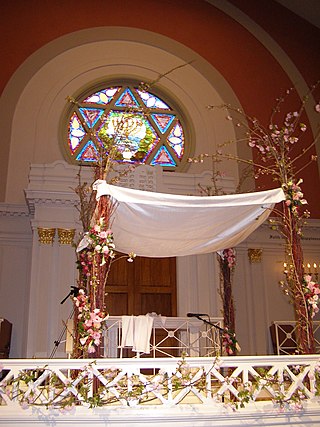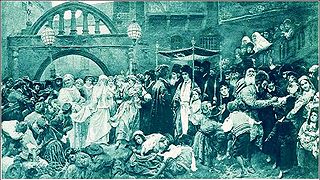
Marriage in Judaism is the documentation of a contract between a Jewish man and a Jewish woman in which God is involved. In Judaism, a marriage can end either because of a divorce document given by the man to his wife, or by the death of either party. Certain details, primarily as protections for the wife, were added in Talmudic times.

An engagement or betrothal is the period of time between the declaration of acceptance of a marriage proposal and the marriage itself. During this period, a couple is said to be fiancés, betrothed,intended, affianced, engaged to be married, or simply engaged. Future brides and grooms may be called fiancée (feminine) or fiancé (masculine), the betrothed, a wife-to-be or husband-to-be, respectively. The duration of the courtship varies vastly, and is largely dependent on cultural norms or upon the agreement of the parties involved.

Halitsah or chalitzah in Rabbinical Judaism the process by which a childless widow and a brother of her deceased husband may avoid the duty to marry under the biblical system of yibbum
Nashim is the third order of the Mishnah containing family law. Of the six orders of the Mishnah, it is the shortest.
Seder Zeraim is the first of the six orders, or major divisions, of the Mishnah, Tosefta, and the Talmud, and, apart from the first tractate which concerns the rules for prayers and blessings, primarily deals with the laws of agricultural produce and tithes of the Torah which apply in the Land of Israel, in both their religious and social aspects.

Targum Onkelos is the primary Jewish Aramaic targum ("translation") of the Torah, accepted as an authoritative translated text of the Five Books of Moses and thought to have been written in the early second century CE.
Yibbum is the form of levirate marriage found in Judaism. As specified by Deuteronomy 25:5–10, the brother of a man who died without children is permitted and encouraged to marry the widow. However, if either of the parties refuses to go through with the marriage, both are required to go through a ceremony known as halizah, involving a symbolic act of renunciation of their right to perform this marriage.
In Islam, a mahr is the obligation, in the form of money, possessions or teaching of verses from the Quran by the groom, to the bride at the time of the Islamic Wedding. While the mahr is often money, it can also be anything agreed upon by the bride such as jewelry, home goods, furniture, a dwelling or some land. Mahr is typically specified in the marriage contract signed upon marriage.

A ketubah is a Jewish marriage contract. It is considered an integral part of a traditional Jewish marriage, and outlines the rights and responsibilities of the groom, in relation to the bride. In modern practice, the ketubah has no agreed monetary value, and is seldom enforced by civil courts, except in Israel.
Samuel ben Meir, after his death known as the "Rashbam", a Hebrew acronym for RAbbi SHmuel Ben Meir, was a leading French Tosafist and grandson of Shlomo Yitzhaki, "Rashi".

A chuppah is a canopy under which a Jewish couple stand during their wedding ceremony. It consists of a cloth or sheet, sometimes a tallit, stretched or supported over four poles, or sometimes manually held up by attendants to the ceremony. A chuppah symbolizes the home that the couple will build together.

A Mikraot Gedolot, often called a "Rabbinic Bible" in English, is an edition of the Hebrew Bible that generally includes three distinct elements:
Sheva Brachot, also known as birkot nissuin in Halakha are blessings that have historically been recited during the wedding of a Jewish couple. There are two stages to a Jewish wedding: betrothal (erusin) and establishing the full marriage (nissuin). Historically, there was a year between the two events, but the two are combined during contemporary Jewish wedding ceremonies. Although the Sheva Brachot are recorded and recited as a harmonious unit, the blessings are actually a mosaic of Biblical origination. It is uncertain who composed the benedictions in the form recorded in the Talmud, but the blessings likely originated centuries before their inclusion in tractate Ketubot.

Sifre refers to either of two works of Midrash halakha, or classical Jewish legal biblical exegesis, based on the biblical books of Numbers and Deuteronomy.

A Jewish wedding is a wedding ceremony that follows Jewish laws and traditions. While wedding ceremonies vary, common features of a Jewish wedding include a ketubah which is signed by two witnesses, a chuppah or huppah, a ring owned by the groom that is given to the bride under the canopy, and the breaking of a glass.
Shalom bayit is the Jewish religious concept of domestic harmony and good relations between husband and wife. In a Jewish court of law, shalom bayit is the Hebrew term for marital reconciliation.
Badeken, Bedeken, Badekenish, or Bedekung, is the ceremony where the groom veils the bride in a Jewish wedding.
Jewish commentaries on the Bible are biblical commentaries of the Hebrew Bible from a Jewish perspective. Translations into Aramaic and English, and some universally accepted Jewish commentaries with notes on their method of approach and also some modern translations into English with notes are listed.
Forbidden relationships in Judaism are intimate relationships which are forbidden by prohibitions in the Torah or rabbinical injunctions.
A bat-kohen or bat kohen is the daughter of a kohen, who holds a special status in the Hebrew Bible and rabbinical texts. She is entitled to a number of rights and is encouraged to abide by specified requirements, for example, entitlement to consume some of the priestly gifts, and an increased value for her ketubah.












